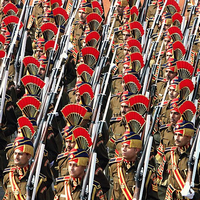NEW DELHI -- Fly three hours in just about any direction from New Delhi's Indira Gandhi International Airport, and you're likely to land in a zone of either ongoing or recently resolved armed conflict -- Afghanistan, Pakistan, Bangladesh and Burma for the former, Sri Lanka and Nepal for the latter. What might be surprising, though, is that those odds are not diminished if you travel by road within India. As a result of structural complexities inherent to the Indian state, New Delhi faces internal security challenges that range from terrorism and militant Naxal extremism to insurgencies and proxy wars.
Violence, whether internally or externally driven, is a way of life in India. The 2008 Mumbai terrorist attacks along with the spate of bombings across the country would prompt one to believe that terrorism must be at the forefront of people's minds. Yet Prime Minister Manmohan Singh recently claimed that instead, Naxalism was "the greatest internal security threat" to India.
The idea of a Naxalite insurrection running from Pashupati (a holy site in the north) to Tirupati (a temple in the south) may be a media exaggeration. But there is no denying the fact that this threat plagues large parts of central India, including but not limited to the states of Andhra Pradesh, Chhattisgarh, Jharkhand, Orissa, Maharashtra and Bihar. The movement represents a severe indictment of the Indian state's ability to meet various socio-economic aspirations and has its roots in the exclusionary politics and the dispossession of poor peasants that dates back to the 1960s.

